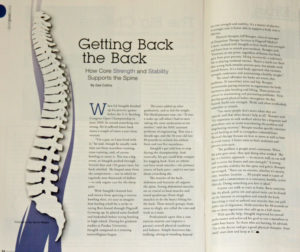![]() May 2011
May 2011
 When Ed Smaglik finished up his practice games before the U.S. Bowling Congress Open Championship in June 2009, he sensed something was amiss. He’d suffered lower back issues a couple of times a year from overuse.
When Ed Smaglik finished up his practice games before the U.S. Bowling Congress Open Championship in June 2009, he sensed something was amiss. He’d suffered lower back issues a couple of times a year from overuse.
“I’m a guy, so I just lived with it,” he said, though he usually took time out from marathon running, cross training, and, of course, bowling to nurse it. This was a big event, so Smaglik pushed through. Several days and 120 games later, his back rebelled. He limped away from the competition–one in which he regularly won thousands of dollars–to seek urgent care for the sharp pain.
With Smaglik’s buzzed hair and sinewy form sporting a veteran bowling shirt, it’s easy to imagine him hurling a ball for a strike or racing fleet-footed through Flagstaff. Growing up, he played some football and basketball before trying bowling in high school. During his graduate studies at Purdue University, Smaglik competed in a winning intercollegiate league.
The years added up after graduation, and so did the weight. His blood pressure rose, too. “It was a wake-up call when I had to start taking the same medication as my mother,” said the NAU assistant professor of engineering. That was a decade ago, and the 34-year old lost 80 pounds to reclaim his athletic form and run five marathons.
Smaglik’s gut had told him to stop during the bowling championship. And ironically, his gut could help conquer his nagging back. Even an athlete can have weak muscles–the primary source of back pain–and it’s not just about crunching abs.
The muscles of the back, abdomen and buttocks all support the spine. Strong abdominal muscles are as crucial as back muscles and toned quadriceps (front thigh muscles) to do the heavy lifting for the back. These muscle groups, from torso to thigh, are called the core and work as a team.
Professionals agree that a core exercise routine can improve a person’s overall physical condition and balance. Simple functions like walking, sitting or standing depend on core strength and stability. It’s a matter of physics – a stronger core is better able to support a body over a lifetime.
Physical therapist Jeff Beaupre, clinical manager of Outpatient Therapy Services at Flagstaff Medical Center, worked with Smaglik to heal, build core strength and learn how to stretch post-workout. Beaupre said, “Everyone at one point – regardless of fitness – has back pain from poor posture, lifting incorrectly, a sedentary life or playing weekend warrior. There’s a myth out there that strong back muscles prevent pain, but people need overall fitness. It’s a total body approach that includes strength, endurance and maintaining a healthy weight.”
The usual offenders for backs are strain, disc problems, SI (sacroiliac) joint and hip. Beaupre recommends paying attention to ergonomics for body mechanics plus bending and lifting. Three points are critical to maintaining and preventing problems: First, develop physical good habits throughout the day. Second, build core strength. Third, and often overlooked, remember to stretch.
“Too many people don’t move when they are injured, and that often doesn’t help at all,” Beaupre said. “It’s important to seek medical advice for a diagnosis and immediate care to avoid exacerbating the problem and lengthening recovery.” Beaupre teaches specific exercises to aid healing as well as strengthen vulnerabilities. Physical therapy focuses on how to move as well as how to avoid injury. Clients train to heal, maintain and prevent joint pain.
“The problem is people aren’t consistent. When the pain goes away, they quit doing what worked. The key is a holistic approach–to exercise well, to eat well and to strive for fitness and core strength.” A strong core provides stability for the spine and pelvis. Beaupre encouraged, “There are no excuses, whether it’s money, time, weather, location… All people need is a pair of shoes and a commitment to a consistent healthy, active lifestyle. Doing something you love is ideal.”
Anyone can walk or train at home. Basic exercises like the plank, pelvic tilt and spinal twist can be found on the Internet to strengthen and stretch the back. Stretching is vital to unbind taut muscles that can pull joints out of alignment. Hold stretches for 90 seconds or two or three repetitions that add up to a full count.
|
|
With specific help, Smaglik improved his overall performance and achieved his goal to run a marathon in under four hours. To those who are hurting, he advised, “Go to the doctor and get a good physical therapist. Start small, start slow and keep at it.”
